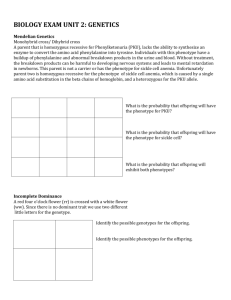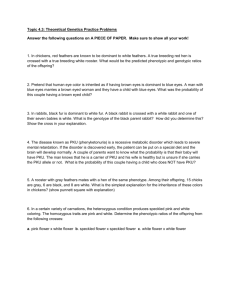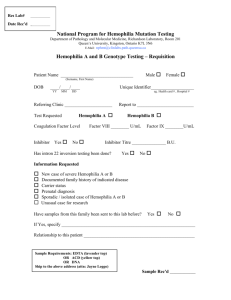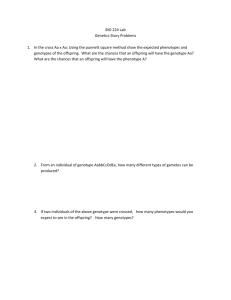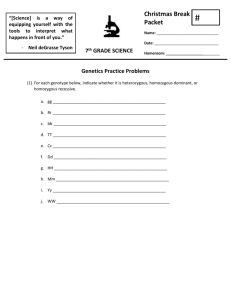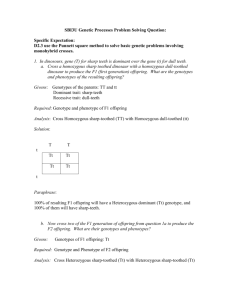Module 5: Genetics III -- Answers to Mendelian genetics problems
advertisement
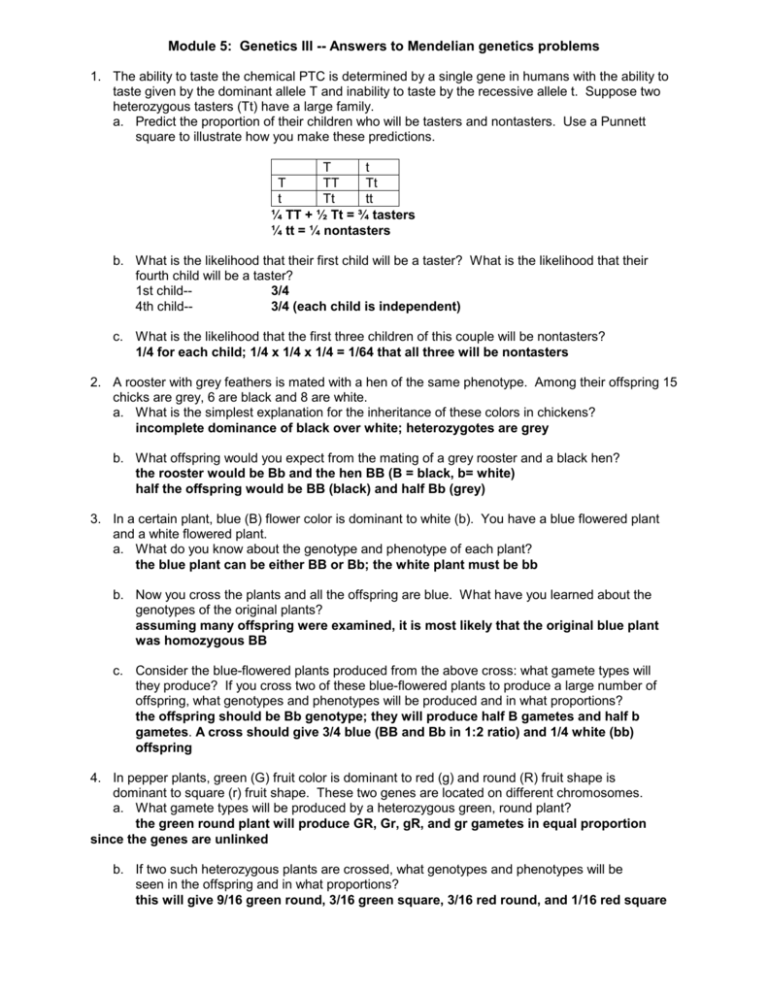
Module 5: Genetics III -- Answers to Mendelian genetics problems 1. The ability to taste the chemical PTC is determined by a single gene in humans with the ability to taste given by the dominant allele T and inability to taste by the recessive allele t. Suppose two heterozygous tasters (Tt) have a large family. a. Predict the proportion of their children who will be tasters and nontasters. Use a Punnett square to illustrate how you make these predictions. T t T TT Tt t Tt tt ¼ TT + ½ Tt = ¾ tasters ¼ tt = ¼ nontasters b. What is the likelihood that their first child will be a taster? What is the likelihood that their fourth child will be a taster? 1st child-3/4 4th child-3/4 (each child is independent) c. What is the likelihood that the first three children of this couple will be nontasters? 1/4 for each child; 1/4 x 1/4 x 1/4 = 1/64 that all three will be nontasters 2. A rooster with grey feathers is mated with a hen of the same phenotype. Among their offspring 15 chicks are grey, 6 are black and 8 are white. a. What is the simplest explanation for the inheritance of these colors in chickens? incomplete dominance of black over white; heterozygotes are grey b. What offspring would you expect from the mating of a grey rooster and a black hen? the rooster would be Bb and the hen BB (B = black, b= white) half the offspring would be BB (black) and half Bb (grey) 3. In a certain plant, blue (B) flower color is dominant to white (b). You have a blue flowered plant and a white flowered plant. a. What do you know about the genotype and phenotype of each plant? the blue plant can be either BB or Bb; the white plant must be bb b. Now you cross the plants and all the offspring are blue. What have you learned about the genotypes of the original plants? assuming many offspring were examined, it is most likely that the original blue plant was homozygous BB c. Consider the blue-flowered plants produced from the above cross: what gamete types will they produce? If you cross two of these blue-flowered plants to produce a large number of offspring, what genotypes and phenotypes will be produced and in what proportions? the offspring should be Bb genotype; they will produce half B gametes and half b gametes. A cross should give 3/4 blue (BB and Bb in 1:2 ratio) and 1/4 white (bb) offspring 4. In pepper plants, green (G) fruit color is dominant to red (g) and round (R) fruit shape is dominant to square (r) fruit shape. These two genes are located on different chromosomes. a. What gamete types will be produced by a heterozygous green, round plant? the green round plant will produce GR, Gr, gR, and gr gametes in equal proportion since the genes are unlinked b. If two such heterozygous plants are crossed, what genotypes and phenotypes will be seen in the offspring and in what proportions? this will give 9/16 green round, 3/16 green square, 3/16 red round, and 1/16 red square phenotypes; the genotypes are given in the Punnett square below GR Gr gR gr GR GGRR GGRr GgRR GgRr Gr GGRr GGrr GgRr Ggrr gR GgRR GrRr ggRR ggRr gr GgRr Ggrr ggRr ggrr G_R_ = green, round ggR_ = red, round G_rr = green, square ggrr = red, square 5. Hemophilia is a sex-linked trait (see pp. 13-6 - 13-7 in your text) where XH gives normal blood clotting and is dominant to the hemophilia allele Xh. a. Give the genotypes of 1) a woman with normal blood clotting whose father had hemophilia and 2) a normal man whose father had hemophilia. 1) the woman has normal clotting so she has one XH but she got Xh from her father 2) the man is XHY since he got the Y from his father and he is normal so must be XH b. What is the probability that a mating between these two individuals will produce a child, regardless of sex, that has hemophilia? X XH XH XH Y XH Y H Xh Xh XH Xh Y each child has a 1/2 chance of being male and males have a 1/2 chance of being affected; so 1/4 chance of a child with hemophilia c. If this couple has a daughter, what is the probability that the daughter will be a carrier of the hemophilia trait? 1/2 chance of being a carrier What is the probability a daughter would have hemophilia? 0 chance that a daughter would have hemophilia d. If this couple has a son, what is the probability he will have hemophilia? 1/2 chance 6. You are interested in two traits in rabbits, each of which is controlled by a separate gene with two alleles: coat color (brown, B, is completely dominant to white, b) and tail (tailed, T, is completely dominant to tail-less, t). You cross a brown, tailed rabbit that is heterozygous at both loci with a white, tail-less rabbit and produce a large number of offspring. Among the offspring you find only two phenotypes in equal proportions: brown, tailed and white, tail-less. Explain the pattern of inheritance of these traits. Draw the chromosomes for the parents and show the gametes that are produced by each during the process of meiosis. These genes must be tightly linked. The chromosomes are shown. Only BT and bt gametes will be formed.


